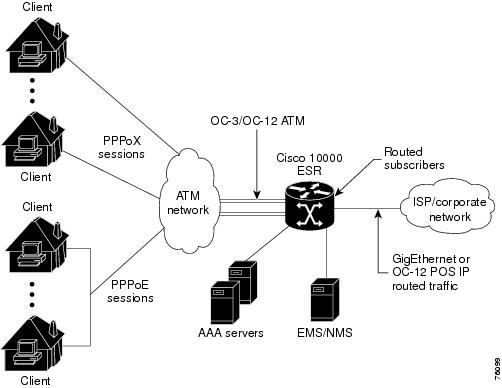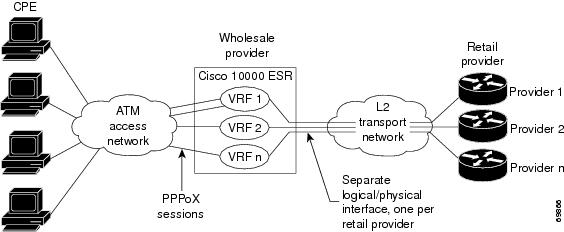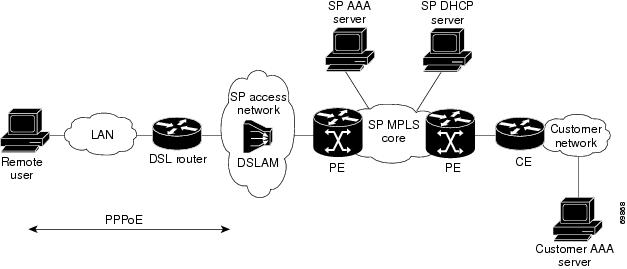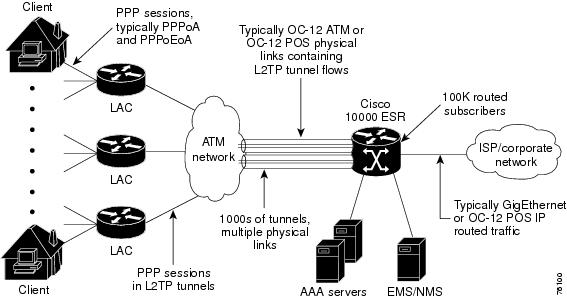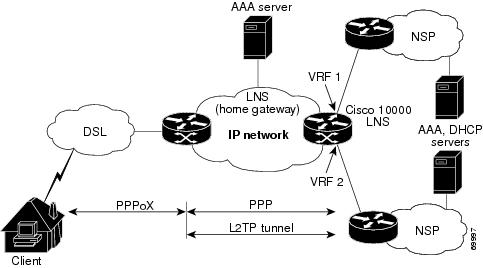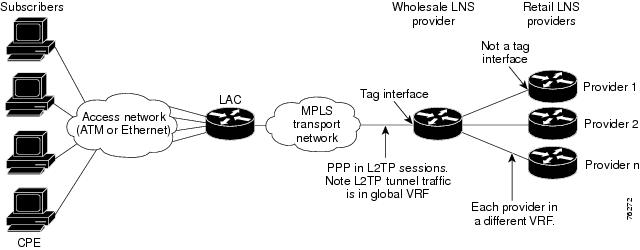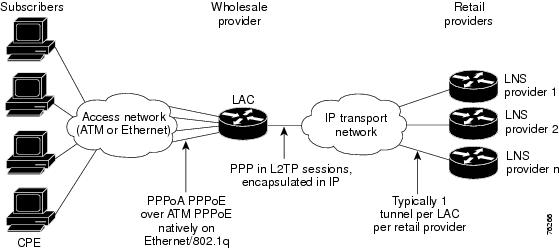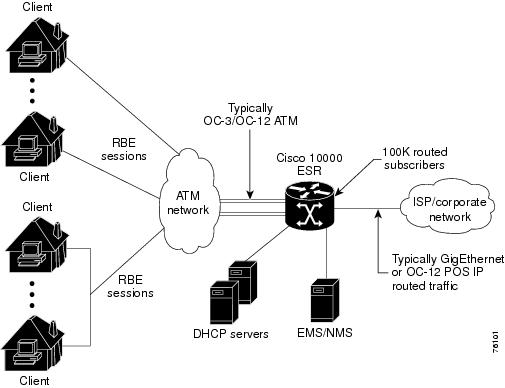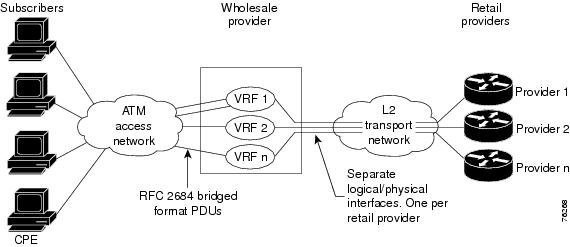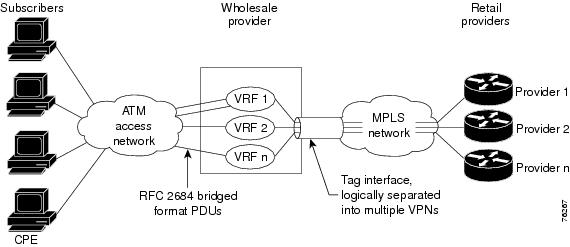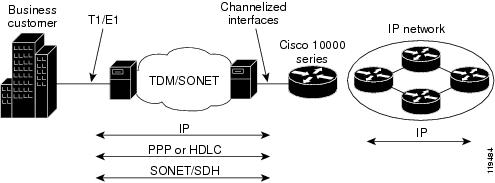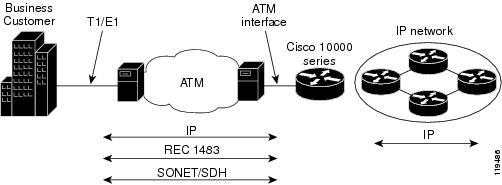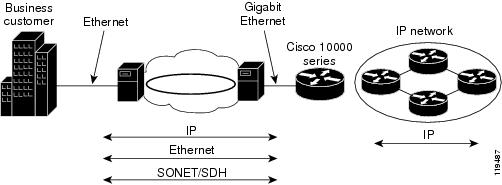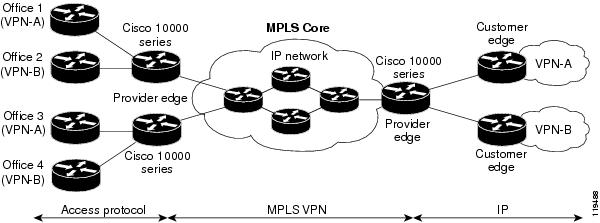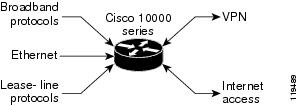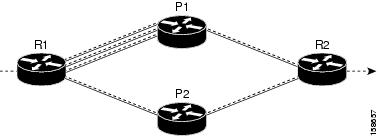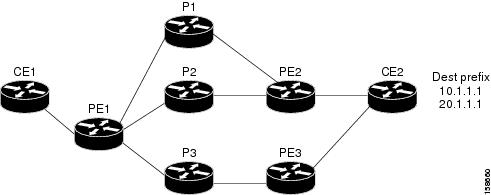

-
Cisco 10000 Series Router Software Configuration Guide
-
About This Guide
-
Broadband Aggregation and Leased-Line Overview
-
Scalability and Performance
-
Configuring Remote Access to MPLS VPN
-
Configuring Multiprotocol Label Switching
-
Configuring the Layer 2 Tunnel Protocol Access Concentrator and Network Server
-
Configuring PPPoE over Ethernet and IEEE 802.1Q VLAN
-
Configuring IP Unnumbered on IEEE 802.1Q VLANs
-
Configuring ATM Permanent Virtual Circuit Autoprovisioning
-
Configuring the Multihop Feature
-
Configuring Address Pools
-
Configuring Local AAA Server, User Database--Domain to VRF
-
Configuring Traffic Filtering
-
Unicast Reverse Path Forwarding
-
Configuring Automatic Protection Switching
-
Configuring IP Multicast
-
Configuring RADIUS Features
-
Cisco 10000 Series Router PXF Stall Monitor
-
SSO - BFD
-
Configuring Link Noise Monitoring
-
Configuring L2 Virtual Private Networks
-
Configuring L2VPN Interworking
-
Configuring Multilink Point-to-Point Protocol Connections
-
Configuring Gigabit EtherChannel Features
-
Configuring IP Version 6
-
Configuring Template ACLs
-
Protecting the Router from DoS Attacks
-
IP Tunneling
-
RADIUS Attributes
-
Glossary
-
Table Of Contents
Broadband Aggregation and Leased-Line Overview
Checking Hardware and Software Compatibility
PPP Termination and Aggregation Architectures
PTA to Virtual Routing and Forwarding Architecture
PTA to Multiprotocol Label Switching Virtual Private Network Architecture
L2TP to Virtual Routing and Forwarding Architecture
L2TP over MPLS to Virtual Routing and Forwarding Instance
L2TP Access Concentrator Architecture
Routed Bridge Encapsulation Architectures
RBE to Virtual Routing and Forwarding Architecture
RBE to Multiprotocol Label Switching Virtual Private Network Architecture
Leased-Line Architecture Models
MPLS Provider Edge Applications
Combined Broadband and Leased-Line Applications
Load Balancing Architecture Models
Single Ingress and Single Egress Provider Edge Applications
Single Ingress and Two Egress Provider Edge Applications
Multiple Ingress and Multiple Egress Provider Edge Applications
New Features, Enhancements, and Changes
New Features in Cisco IOS Release 12.2(33)XNE3
New Features in Cisco IOS Release 12.2(33)XNE
New Features in Cisco IOS Release 12.2(33)SB3
New Features in Cisco IOS Release 12.2(33)SB2
New Features in Cisco IOS Release 12.2(33)SB
New Features in Cisco IOS Release 12.2(31)SB5
New Features in Cisco IOS Release 12.2(31)SB3
New Features in Cisco IOS Release 12.2(31)SB2
New Features in Cisco IOS Release 12.2(28)SB1
New Features in Cisco IOS Release 12.2(28)SB
New Features in Cisco IOS Release 12.3(7)XI7
New Features in Cisco IOS Release 12.3(7)XI3
New Features in Cisco IOS Release 12.3(7)XI2
New Features in Cisco IOS Release 12.3(7)XI1
Broadband Aggregation and Leased-Line Overview
The Cisco 10000 series router is a highly scalable and reliable IP edge platform, providing nonstop performance for service providers deploying IP services. With the rapid growth in broadband customers, the Cisco 10000 series router accommodates the service provider's need for an expanding set of broadband aggregation features.
This chapter provides an overview of the broadband aggregation features available on the Cisco 10000 series router and includes the following topics:
•
Broadband Architecture Models
•
Leased-Line Architecture Models
•
Load Balancing Architecture Models
•
New Features, Enhancements, and Changes
Hardware Requirements
The performance routing engine (PRE) performs all Layer 2 and Layer 3 packet manipulation related to routing and forwarding operations. Table 1-1 shows PRE support on Cisco 10000 series routers.
Table 1-1 PRE Support on Cisco 10000 Series Routers
Cisco 10005
Yes
Yes
No
No
Cisco 10008
Yes
Yes
Yes
Yes
Checking Hardware and Software Compatibility
The PRE installed in the Cisco 10000 series router chassis must support the Cisco IOS software running on the router. Use the show version command to check the PRE version installed.
To see if a feature is supported by a Cisco IOS release, to locate the software document for that feature, or to check the minimum software requirements of Cisco IOS software with the hardware installed on your router, Cisco maintains the Software Advisor tool on Cisco.com at http://www.cisco.com/pcgi-bin/Support/CompNav/Index.pl
You must be a registered user on Cisco.com to access this tool.
Broadband Architecture Models
This section shows broadband models for the following architectures:
•
PPP termination and aggregation (PTA) for PPPoA or PPPoE
•
PTA to virtual routing and forwarding (VRF)
•
PTA to Multiprotocol Label Switching (MPLS) Virtual Private Network (VPN)
•
L2TP network server (LNS)
•
L2TP to VRF
•
L2TP over MPLS to VRF
•
L2TP access concentrator (LAC)
•
Routed bridge encapsulation (RBE)
•
RBE to VRF
•
RBE to MPLS VPN
PPP Termination and Aggregation Architectures
Figure 1-1 shows a PPP termination and aggregation (PTA) model for PPP over ATM (PPPoA) or PPP over Ethernet (PPPoE) sessions.
Figure 1-1 PTA Architectural Model
In the figure, an ATM network (with no routing capability) is between the clients and the Cisco 10000 series router. Each client session arrives on a VC (multiple sessions and PCs can use this single VC). The IP traffic of the client is encapsulated in PPPoX. The Cisco 10000 series router terminates the PPP sessions and routes the client data packets toward their final destination, typically onto the ISP or corporate network.
Note
PPPoX refers to either PPPoA or PPPoE.
PTA to Virtual Routing and Forwarding Architecture
Figure 1-2 shows a PPP termination and aggregation (PTA) to virtual routing and forwarding (VRF) model for PPPoA or PPPoE sessions.
Figure 1-2 PTA to VRF Architectural Model
In this model, the Cisco 10000 series router terminates the sessions and places the sessions in the appropriate VRF. This model is identical to the one in Figure 1-3 on the access side. However, the two models differ on the network side. The model in Figure 1-2 uses VRFs, does not use a tag interface on the network side, and separates traffic at Layer 2. The "PTA to MPLS VPN Architectural Model" in Figure 1-3 uses MPLS and a tag interface, and separates traffic at Layer 3.
PTA to Multiprotocol Label Switching Virtual Private Network Architecture
Figure 1-3 shows a MPLS VPN model for PPPoA or PPPoE sessions.
Figure 1-3 PTA to MPLS VPN Architectural Model
In the figure, PPPoX sessions are placed in the proper virtual routing and forwarding (VRF) instance based on the virtual template to which they map. This model is identical to the one in Figure 1-2 on the access side. However, the two models differ on the network side. The model in Figure 1-3 uses MPLS and a tag interface on the network side and separates traffic at Layer 3. The "PTA to VRF Architectural Model" in Figure 1-2 uses VRFs does not use a tag interface, and separates traffic at Layer 2.
L2TP Architectures
Figure 1-4 shows an L2TP network server (LNS) model.
Figure 1-4 LNS Architectural Model
In the figure, the clients and the LACs exchange PPP packets that are typically encapsulated in PPPoA or PPPoE and typically carried on ATM circuits. However, the protocols used between the clients and the LAC do not affect LNS requirements. The LAC creates L2TP tunnels to all of the LNSs at which its clients want to terminate. Multiple tunnels might exist between each LAC and each LNS. For each client PPP session the LAC signals the LNS to add another session to a tunnel. The LAC forwards all traffic to the LNS, including the PPP control traffic. The LNS terminates the PPP sessions and routes any client IP packets on to the ISP or corporate network toward their final destination. The LNS performs authentication, authorization, and accounting (AAA) actions on the PPP sessions.
L2TP to Virtual Routing and Forwarding Architecture
Figure 1-5 shows an L2TP to VRF model.
Figure 1-5 L2TP to VRF Architectural Model
In this model, the Cisco 10000 series router acts as the LNS with VRF 1 and VRF 2 configured on the router. PPPoX sessions are placed in an L2TP tunnel and terminated at the LNS where they are placed in the appropriate VRF.
L2TP over MPLS to Virtual Routing and Forwarding Instance
Figure 1-6 shows PPP in L2TP tunneled traffic transported over an MPLS tag interface to the wholesale LNS provider.
Figure 1-6 L2TP over MPLS to VRF Architectural Model
The LNS encapsulates the PPP in L2TP sessions in IP packets and forwards them to the retail LNS providers, placing the sessions for each provider in separate VRFs.
L2TP Access Concentrator Architecture
Figure 1-7 shows an L2TP access concentrator (LAC) model.
Figure 1-7 LAC Topology
In the figure, wholesale providers tunnel subscriber PPP sessions to the retail provider. PPP in L2TP sessions are encapsulated in IP packets and forwarded over any IP transport network.
Routed Bridge Encapsulation Architectures
Figure 1-8 shows a routed bridge encapsulation (RBE) model.
Figure 1-8 RBE Architectural Model
In the figure, an ATM network (with no routing capability) is between the clients and the Cisco 10000 series router. Each client session arrives on a VC (multiple sessions and PCs can use this single VC). IP traffic of the client is encapsulated in RBE. The Cisco 10000 series router processes ARP or DHCP requests and routes the client data packets toward their final destination, typically onto the ISP or corporate network.
RBE to Virtual Routing and Forwarding Architecture
Figure 1-9 shows an RBE to VRF model.
Figure 1-9 RBE to VRF Topology
In the figure, the wholesale provider uses physical or logical interfaces to separate the subscribers of different retail providers. On the access side, the subscribers are uniquely placed in VRFs. A separate physical or logical interface to each retail provider separates traffic for the different retail providers on the network side.
RBE to Multiprotocol Label Switching Virtual Private Network Architecture
Figure 1-10 shows an RBE to MPLS VPN model.
Figure 1-10 RBE to MPLS VPN Topology
In the figure, the wholesale provider uses VPNs to separate the subscribers of different retail providers. On the access side, the subscribers are uniquely placed in VRFs. A tag interface separates traffic for the different retail providers on the network side. The MPLS VPN technology is used to assign tags in a VPN aware manner.
Leased-Line Architecture Models
This section shows leased-line models for the following architectures and applications:
•
Channelized aggregation
•
Frame Relay aggregation
•
ATM aggregation
•
Ethernet aggregation
•
MPLS provider edge application
•
Combined Broadband and Leased-Line applications
Channelized Aggregation
The Cisco 10000 series router allows the aggregation of low-speed, very-high-density leased-line circuits by using channelized interfaces. Figure 1-11 shows an example of channelized architecture.
Figure 1-11 Channelized Architecture
In a typical Cisco 10000 series router application, the provider usually situates the aggregator in a centrally located POP and backhauls individual customer connections from central offices across the SONET/SDH networks. Add-drop multiplexers at either end of the optical network that provide aggregation of low-speed customer connections (T1/E1) and aggregation into higher-order optical interfaces in the central POP. Numerous IP services are supported over channelized interfaces, including IP QoS, ACLs, IP multicast, and security services.
Frame Relay Aggregation
Many service providers offer IP Internet access and VPN products over existing Frame Relay access networks. Frame Relay packet-switched networks allow flexibility to allocate resources based on traffic profiles. When aggregating Frame Relay circuits, the Cisco 10000 series router is usually located in a central POP and connects to local switch nodes through copper or optical interfaces. Typically, these connections are implemented with nonchannelized interfaces. Frame Relay data-link connection identifiers (DLCIs) are terminated on the Cisco 10000 series router with customer IP traffic routed through the core network. Frame Relay encapsulation is supported on many interfaces, including channelized and nonchannelized modules. Numerous Frame Relay options and services are supported on the platform, including traffic shaping and QoS.
Figure 1-12 shows an example of Frame Relay architecture.
Figure 1-12 Frame Relay Architecture
ATM Aggregation
ATM is used in many local exchange carrier (ILEC) and PTT access networks, and many providers use the technology as the foundation for multiservice platforms. ATM can be used to provide transport services for many applications, including backhaul for DSL services and leased-line emulation for Internet and VPN services.
Figure 1-13 shows an example of ATM architecture.
Figure 1-13 ATM Architecture
When used as an ATM aggregator, the Cisco 10000 series router is usually placed in a central POP and connected to a local ATM switching node through optical interfaces. ATM virtual circuits are terminated on the device, and customer IP traffic destined for the Internet or VPN is routed onto the core network.
The Cisco 10000 series router supports ATM classes of service (CoSs), including UBR, UBR+, VBR-nrt, and CBR with extensive IP QoS to ATM CoS interworking. The ATM feature set includes accurate and scalable traffic shaping as well as operations, administration, and maintenance (OAM) facilities.
Ethernet Aggregation
Many enterprise customers use Ethernet technology for the "hub" site within a VPN network. "Spoke" sites are generally connected to the service provider infrastructure with lower speed fixed circuits. Customer connections are usually defined as 802.1Q virtual LAN (VLAN) logical interfaces under the main Ethernet interface. The Cisco 10000 series router supports both Gigabit and Fast Ethernet interfaces with many IP services, including QoS and ACLs.
Figure 1-14 shows an example of Ethernet architecture.
Figure 1-14 Ethernet Architecture
MPLS Provider Edge Applications
MPLS technology has allowed providers to target small to medium-sized businesses for outsourced VPN services. The "build once, sell many" approach of the network design provides scalability and flexibility with respect to VPN products and services. MPLS provider edge functions and associated features and services are offered on the Cisco 10000 series router, spanning all interfaces and encapsulations from low-speed broadband to traditional leased-line applications to high-speed Ethernet.
Figure 1-15 shows an example of MPLS architecture.
Figure 1-15 MPLS Architecture
Combined Broadband and Leased-Line Applications
The demarcation between leased-line and broadband applications has become less clear over the past few years. DSL circuits are competing in the traditional leased-line space, with many service providers offering Internet and VPN services over these lower-cost alternatives to dedicated TDM. The role of the leased-line aggregator has expanded to include the termination of many traditional broadband interfaces and encapsulations. Combining leased-line and business-class DSL access is one option that many providers are introducing to reduce costs and consolidate the number of edge products.
Figure 1-16 shows an example of combined broadband and leased-line architecture.
Figure 1-16 Combined Broadband and Leased-Line Architecture
Load Balancing Architecture Models
This section describes how the Cisco 10000 series router load balances traffic in various network topologies. The scenarios apply to a Cisco 10000 series router with a PRE2.
IP and MPLS Applications
Figure 1-17 shows a simple network topology that uses IP or basic MPLS forwarding. It does not include MPLS VPN routes. There are multiple outgoing paths from the R1 router to the R2 router. Load balancing is achieved by populating multiple paths in the PXF. On a Cisco 10000 series router, load balancing is supported on a maximum of eight unique paths.
Figure 1-17 IP and MPLS Load Balancing
You can set load balancing to work per-destination or per-packet. For per-destination load balancing, the packet arrives at R1 and the hash value is computed based on the source IP address, destination IP address, and router ID. The PXF has a proprietary algorithm to select a path based on the number of total paths available.
Per-packet load balancing allows data traffic to be evenly distributed in an IP network over multiple equal-cost connections. Per-packet load balancing uses round-robin techniques to select the output path without basing the choice on the packet content.
Single Ingress and Single Egress Provider Edge Applications
Figure 1-18 shows the provider edge 1 (PE1) router with three Interior Gateway Protocol (IGP) routes into the core. Load balancing from customer edge 1 (CE1) to CE2 occurs on the PE1 router into different paths. There is a single path for all destination prefixes on CE2 and a separate path for all destination prefixes on CE4.
Figure 1-18 Single Ingress and Single Egress PE Load Balancing
For each destination prefix on a destination CE that requires unique Label Switched Path (LSP), selection of the outgoing IGP path is in round-robin fashion. When there are multiple IGP paths from the ingress PE to egress PE, the outgoing IGP path is chosen statically upon processing by the PXF. For different destination prefixes, path selection is round-robin and each destination prefix has only one path. All destination IP addresses mapping to the same destination prefix take the same path.
When there are multiple destination prefixes, load balancing occurs on traffic across the IGP paths. In the case of only one or a few destination prefixes, load balancing does not occur on traffic across the IGP paths and this behavior is the same whether load balancing is configured per-destination or per-packet.
Single Ingress and Two Egress Provider Edge Applications
Figure 1-19 shows the routing of packets from CE1 to CE2 using the PE1 router. There are multiple paths for the destination prefixes on CE2. Load balancing occurs in the PXF of PE1.
Figure 1-19 Single Ingress and Two Egress PE Load Balancing
You can set load balancing to work per-destination or per-packet. For per-destination load balancing, the packet arrives at the core router and the hash value is computed based on the source IP address, destination IP address, and router ID. The PXF has a proprietary algorithm to select a path based on the number of total paths available.
Per-packet load balancing allows data traffic to be evenly distributed in an IP network over multiple equal-cost connections. Per-packet load balancing uses round-robin techniques to select the output path without basing the choice on the packet content.
Multiple Ingress and Multiple Egress Provider Edge Applications
Figure 1-20 shows multiple IGP paths from PE to PE for iBGP paths into the PE2 router. The theoretical load balance is eight IGP paths multiplied by eight iBGP paths for a total of 64 possible unique paths. The Cisco 10000 series router supports eight unique paths. The "Single Ingress and Single Egress Provider Edge Applications" section describes the path selection for this model.
Figure 1-20 Multiple Ingress and Multiple Egress PE Load Balancing
New Features, Enhancements, and Changes
The following sections describe features that are new, enhanced, or changed for the specified Cisco IOS software releases:
•
New Features in Cisco IOS Release 12.2(33)XNE3
•
New Features in Cisco IOS Release 12.2(33)XNE
•
New Features in Cisco IOS Release 12.2(33)SB3
•
New Features in Cisco IOS Release 12.2(33)SB2
•
New Features in Cisco IOS Release 12.2(33)SB
•
New Features in Cisco IOS Release 12.2(31)SB5
•
New Features in Cisco IOS Release 12.2(31)SB3
•
New Features in Cisco IOS Release 12.2(31)SB2
•
New Features in Cisco IOS Release 12.2(28)SB1
•
New Features in Cisco IOS Release 12.2(28)SB
•
New Features in Cisco IOS Release 12.3(7)XI7
•
New Features in Cisco IOS Release 12.3(7)XI3
•
New Features in Cisco IOS Release 12.3(7)XI2
•
New Features in Cisco IOS Release 12.3(7)XI1
New Features in Cisco IOS Release 12.2(33)XNE3
In Cisco IOS Release 12.2(33)XNE3 support was added on the Cisco 10000 series router for the following feature:
•
AAA: Supress System Accounting on Switchover
For more information on the command used to enable or disable this feature after a PRE swtichover, see the section "Suppressing System Accounting Records over Switchover" in the Configuring Accounting feature guide at the following link:
New Features in Cisco IOS Release 12.2(33)XNE
In Cisco IOS Release 12.2(33)XNE support was added on the Cisco 10000 series router for the following features:
•
Cisco 10000 Series Router PXF Stall Monitor
For more information, see Cisco 10000 Series Router PXF Stall Monitor, page 17-61
•
SSO-BFD
For more information, see SSO-BFD, page 18-69
•
Link Noise Monitoring
For more information, see Configuring Link Noise Monitoring, page 19-1
•
Routed Interworking
For more information, see Routed Interworking, page 21-4
•
MLPoE at PTA
For more information, see MLPoE at PTA, page 22-25
•
VLAN-Based Load Balancing
For more information, see Configuring VLAN-Based Load Balancing, page 23-12
•
SSO - MPLS VPN 6VPE & 6PE SSO support
For more information, see the NSF/SSO and ISSU - MPLS VPN 6VPE and 6PE guide at the following link:
http://www.cisco.com/en/US/docs/ios/mpls/configuration/guide/mp_6vpe_6pe_issu_sso.html
•
ISSU - MPLS VPN 6VPE & 6PE ISSU support
For more information, see the NSF/SSO and ISSU - MPLS VPN 6VPE and 6PE guide at the following link:
http://www.cisco.com/en/US/docs/ios/mpls/configuration/guide/mp_6vpe_6pe_issu_sso.html
•
BGP IPv6 Graceful Restart
For more information, see the Implementing Multiprotocol BGP for IPv6 guide at the following link:
http://www.cisco.com/en/US/docs/ios/ipv6/configuration/guide/ip6-mptcl_bgp.html
•
BGP Support for 4-byte ASN
For more information, see the following guides at:
–
Configuring a Basic BGP Network
http://www.cisco.com/en/US/docs/ios/iproute_bgp/configuration/guide/irg_basic_net.html
–
Connecting to a Service Provider Using External BGP
http://www.cisco.com/en/US/docs/ios/iproute_bgp/configuration/guide/irg_external_sp.html
–
BGP per Neighbor SoO Configuration
http://www.cisco.com/en/US/docs/ios/iproute_bgp/configuration/guide/irg_neighbor_soo.html
–
Cisco BGP Overview
http://www.cisco.com/en/US/docs/ios/iproute_bgp/configuration/guide/irg_overview.html
•
OSPFv3 Graceful Restart
For more information, see the OSPFv3 Graceful Restart section in the Implementing OSPF for IPv6 guide at the following link:
http://www.cisco.com/en/US/docs/ios/ipv6/configuration/guide/ip6-ospf.html
•
MPLS & LDP over Multilink Frame Relay
For more information, see the following guides at:
–
Multilink Frame Relay (FRF.16.1)
http://www.cisco.com/en/US/docs/ios/wan/configuration/guide/wan_ml_fr_frf161.html
–
Any Transport over MPLS
http://www.cisco.com/en/US/docs/ios/mpls/configuration/guide/mp_any_transport.html
–
Configuring Layer 3 VPNs
http://www.cisco.com/en/US/docs/ios/mpls/configuration/guide/mp_cfg_layer3_vpn.html
•
IS-IS - MPLS LDP Autoconfiguration
For more information, see the MPLS LDP Autoconfiguration guide at the following link:
http://www.cisco.com/en/US/docs/ios/mpls/configuration/guide/mp_ldp_autoconfig.html
New Features in Cisco IOS Release 12.2(33)SB3
In Cisco IOS Release 12.2(33)SB3 support was added on the Cisco 10000 series router for the following feature:
•
IGP Convergence Acceleration
For more information, see IGP Convergence Acceleration, page 4-3
New Features in Cisco IOS Release 12.2(33)SB2
In Cisco IOS Release 12.2(33)SB2 support was added on the Cisco 10000 series router for the following features:
•
MLP at LNS with ATM Tunnel
For more information, see MLP on LNS, page 22-18
•
MLPoE LAC Switching
For more information, see the MLPoE LAC Switching, page 22-24
New Features in Cisco IOS Release 12.2(33)SB
In Cisco IOS Release 12.2(33)SB support was added on the Cisco 10000 series router for the following features:
•
Unicast Reverse Path Forwarding (uRPF)
For more information, see Chapter 13, "Unicast Reverse Path Forwarding"
•
Any Transport over MPLS (AToM): Tunnel Selection
For more information, see the "Any Transport over MPLS—Tunnel Selection" section on page 20-47
•
L2VPN Interworking: Ethernet/VLAN to ATM AAL5
For more information, see the "Ethernet/VLAN to ATM AAL5 Interworking" section on page 21-5
•
L2VPN Interworking: Ethernet/VLAN to Frame Relay
For more information, see the "Ethernet/VLAN to Frame Relay Interworking" section on page 21-17
•
IPv6 VPN over MPLS (6VPE)
For more information, see the "IPv6 VPN over MPLS" section on page 4-7
•
Any Transport over MPLS (AToM): Remote Ethernet Port Shutdown
For more information, see the "Remote Ethernet Port Shutdown" section on page 20-25
•
NSF / SSO - Any Transport over MPLS (AToM)
For more information, see the "NSF and SSO—L2VPN" section on page 20-6
•
L2VPN Local Switching--HDLC/PPP
For more information, see the "L2VPN Local Switching—HDLC/PPP" section on page 20-10
•
MLP at LNS
For more information, see the "MLP on LNS" section on page 22-18
•
IEEE 802.1Q Tunneling (QinQ) for AToM
For more information, see the "IEEE 802.1Q Tunneling for AToM—QinQ" section on page 20-22
•
IGP Convergence Acceleration
This feature allows faster failover of IGP routes in load balanced situation.
•
Gigabit EtherChannel-Enhancements
For more information, see Chapter 23, "Configuring Gigabit EtherChannel Features"
•
ISG:Flow Control: Flow redirect (PXF scaling)
For more information, see "Layer 4 Redirect Scaling" section on page 2-5
•
VRF-Aware VPDN Tunnels
This feature places broadband traffic in a VRF based on the VPDN group. This allows more flexible DSL service at the Layer 2 Network Server (LNS).
New Features in Cisco IOS Release 12.2(31)SB5
In Cisco IOS Release 12.2(31)SB5 support was added for the following features:
•
Generic Routing Encapsulation (GRE) Tunnel IP Source and Destination VRF Membership
For more information, see the "GRE Tunnel IP Source and Destination VRF Membership" section on page 27-1.
•
Per Session Queuing and Shaping for PPPoE Over VLAN Using RADIUS
For more information, see the "Shaping PPPoE Over VLAN Sessions Using RADIUS" section in the "Configuring Dynamic Subscriber Services" chapter of the Cisco 10000 Series Router Quality of Service Configuration Guide, located at the following URL:
New Features in Cisco IOS Release 12.2(31)SB3
In Cisco IOS Release 12.2(31)SB3, support was added on the Cisco 10000 series router for the following features and functionality:
•
IS-IS-MIB
For more information, see the following URL:
http://www.cisco.com/univercd/cc/td/doc/product/software/ios122/122newft/122limit/122sg25/
ismibspt.htm
•
QoS: MQC Classification, Policing, and Marking on LAC
Note
Support for this feature on the PRE3 was introduced in Cisco IOS Release 12.2(31)SB2.
For detailed information about this feature, see the "Shaping Traffic" chapter in the Cisco 10000 Series Router Quality of Service Configuration Guide, located at the following URL:
•
TCP MSS Adjust
For more information, see the "Configuring PPPoE over Ethernet and IEEE 802.1Q VLAN" chapter in the Cisco 10000 Series Router Broadband Aggregation, Leased-Line, and MPLS Configuration Guide, located at the following URL:
New Features in Cisco IOS Release 12.2(31)SB2
In Cisco IOS Release 12.2(31)SB2, support was added on the Cisco 10000 series router for the following features and functionality:
•
ACL - Template ACL/12 Bit ACE
For more information, see the "Configuring Template ACLs" section on page 25-1.
•
Frame Relay - Multilink (MLFR-FRF.16)
For more information, see the following URL:
http://www.cisco.com/en/US/products/sw/iosswrel/ps1838/products_feature_guide09186a0080134a9e.html
•
IEEE 802.1Q-in-Q VLAN Tag Termination
Support was added for the PRE3. For more information, see the following URL:
http://www.cisco.com/en/US/products/sw/iosswrel/ps5207/products_feature_guide09186a00801f0f4a.html•
IP Options Selective Drop
For more information, see the "Protecting the Router from DoS Attacks" section on page 26-1.
•
IPv6 Services: Extended Access Control Lists
For more information, see the "IPv6 Extended ACLs" section on page 24-4.
•
L2TP Domain Screening
For more information, see the following URL:
http://www.cisco.com/en/US/products/sw/iosswrel/ps5413/products_feature_guide09186a00805a0782.html•
L2VPN Interworking — Ethernet to VLAN Interworking
For more information, see the "Ethernet to VLAN—Bridged Interworking" section on page 21-2.
•
MLPPP - Multilink PPP
Support was added for the PRE3 and the valid multilink interface values on the PRE2 and PRE3 for MLP over Serial and Multi-VC MLP over ATM changed from 1 to 9999 (Release 12.2(28)SB and later) to from 1 to 9999 and 65,536 to 2,147,483,647. For more information, see the "Configuring Multilink Point-to-Point Protocol Connections" section on page 22-1.
•
MPLS VPN-VRF Selection based on Source IP Address
For more information, see the following URL: http://www.cisco.com/univercd/cc/td/doc/product/software/ios122/122newft/122limit/122sz/12214sz/122szvrf.htm
•
Multicast VPN Extranet Support
For more information, see the following URL: http://www.cisco.com/univercd/cc/td/doc/product/software/ios122sb/newft/122sb31/extvpnsb.htm
•
Multicast VPN Extranet VRF Select
For more information, see the following URL:
http://www.cisco.com/univercd/cc/td/doc/product/software/ios122sb/newft/122sb31/sbmexsel.htm•
NSF/SSO (Nonstop Forwarding with Stateful Switchover)
Support was added for the PRE3. For more information, see the following URL:
http://www.cisco.com/univercd/cc/td/doc/product/software/ios122s/122snwft/release/122s20/fsnsf20s.htm•
QoS - Policing Support for GRE Tunnels
For more information, see the following URL:
http://www.cisco.com/univercd/cc/td/doc/product/software/ios122sb/newft/122sb31/grepol.htm•
SSO - Multilink Frame Relay
For more information, see the following URL: http://www.cisco.com/univercd/cc/td/doc/product/software/ios122s/122snwft/release/122s20/fssso20s.htm
•
VRF-Aware VPDN Tunnels
For more information, see the following URL:
http://www.cisco.com/univercd/cc/td/doc/product/software/ios122sb/newft/122sb28/sbvpdnmh.htmNew Features in Cisco IOS Release 12.2(28)SB1
IEEE 802.1Q-in-Q VLAN Tag Termination in the PPPoE—QinQ Support feature guide, located at the following URL:
http://www.cisco.com/en/US/products/sw/iosswrel/ps5207/products_feature_guide09186a00801f0f4a.html
New Features in Cisco IOS Release 12.2(28)SB
The following features are new on the Cisco 10000 series router in Cisco IOS Release 12.2(28)SB:
•
AAA CLI Stop Record Enhancement in the Per VRF AAA feature guide, located at the following URL:
http://www.cisco.com/en/US/products/sw/iosswrel/ps1839/products_feature_guide09186a0080518ac1.html
•
Any Transport Over MPLS: Frame Relay over MPLS (FRoMPLS) in Chapter 20, "Configuring L2 Virtual Private Networks"
•
Cisco 10000 series router 4-Port Channelized T3 Half-Height line card (new line card) in the following guides:
–
Cisco 10000 Series Router Line Card Configuration Guide, located at the following URL:
–
Cisco 10000 Series Router Line Card Hardware Installation Guide, located at the following URL:
•
Cisco 10000 series 4-Port OC-3/STM-1c ATM line card (long reach optics added to the existing line card) in the Cisco 10000 Series Router Line Card Hardware Installation Guide, located at the following URL:
•
Commands:
–
Changes to show pxf command output.
–
New commands (pos flag s1-byte tx and pos flag s1-byte rx-communicate) for Packet Over SONET and ATM line cards in the Cisco 10000 Series Router Line Card Configuration Guide, located at the following URL:
–
Changes to the show running vrf command in the MPLS VPN—Show Running VRF feature guide, located at the following URL:
http://www.cisco.com/en/US/products/ps6566/products_feature_guide09186a00805f236c.html
–
New command for providing policy map information in the QoS: Enhanced Show Commands for Active Policies feature guide, located at the following URL:
http://www.cisco.com/en/US/products/ps6566/products_feature_guide09186a0080610cc8.html
•
Define Interface Policy-Map AV Pairs AAA in the Define Interface Policy-Map AV Pairs AAA feature guide, located at the following URL:
http://www.cisco.com/en/US/products/sw/iosswrel/ps5413/products_feature_guide09186a0080335ed5.html
•
Frame Relay PVC Interface Priority Queueing in the Cisco 10000 Series Router Quality of Service Configuration Guide, located at the following URL:
•
Hierarchical Input Policing in the Cisco 10000 Series Router Quality of Service Configuration Guide, located at the following URL:
•
IGMPv3 in the "Configuring IGMP Version 3" section in the "Configuring IP Multicast Routing" chapter of "Part 3: IP Multicast" of the Cisco IOS IP Configuration Guide, Release 12.2.
•
In Service Software Upgrade (ISSU) in the Cisco IOS In Service Software Upgrade and Enhanced Fast Software Upgrade Process feature guide, located at the following URL:
http://www.cisco.com/en/US/products/ps6566/products_feature_guide09186a008063c6e7.html
•
Intelligent Service Architecture features in the Intelligent Service Gateway (ISG) Configuration Library, located at the following URL:
http://www.cisco.com/en/US/products/ps6566/products_feature_guide09186a008064ec11.html
•
IP SLAs—LSP Health Monitor in the IP SLAs—LSP Health Monitor feature guide, located at the following URL:
http://www.cisco.com/en/US/products/ps6566/products_feature_guide09186a0080528450.html
•
IPv6 in Chapter 24, "Configuring IP Version 6"
•
L2TP Congestion Avoidance in the L2TP Congestion Avoidance feature guide, located at the following URL:
http://www.cisco.com/en/US/products/ps6566/products_feature_guide09186a00805f040e.html
•
Layer 2 Local Switching in Chapter 20, "Configuring L2 Virtual Private Networks"
•
Link Fragmentation Interleave Over Frame Relay (FRF.12) in the Cisco 10000 Series Router Quality of Service Configuration Guide, located at the following URL:
•
Logging to Local Non-Volatile Storage (ATA Disk) in the Syslog Writing to Flash feature guide, located at the following URL:
http://www.cisco.com/en/US/products/ps6566/products_feature_guide09186a0080611212.html
•
MLP Connections in Chapter 22, "Configuring Multilink Point-to-Point Protocol Connections"
•
MLPPP with Link Fragmentation Interleave (LFI) in the Cisco 10000 Series Router Quality of Service Configuration Guide, located at the following URL:
•
MPLS Carrier Supporting Carrier (also known as MPLS VPN—Carrier Supporting Carrier) in the following feature guides. These guides are located at the following URL:
http://www.cisco.com/en/US/products/ps6566/products_feature_guides_list.html
–
LDP: MPLS VPN—Carrier Supporting Carrier
–
BGP: MPLS VPN—Carrier Supporting Carrier—IPv4 BGP Label Distribution
•
MPLS Embedded Management—LSP Ping/Traceroute and AToM VCCV in the MPLS Embedded Management—LSP Ping/Traceroute and AToM VCCV feature guide, located at the following URL:
http://www.cisco.com/en/US/products/ps6566/products_feature_guide09186a008063d009.html
•
MPLS Egress Netflow Accounting in the MPLS Egress Netflow Accounting feature guide, located at the following URL:
http://www.cisco.com/en/US/products/ps6566/products_feature_guide09186a0080611269.html
•
MPLS High Availability Overview in the MPLS High Availability: Overview feature guide, located at the following URL:
http://www.cisco.com/en/US/products/sw/iosswrel/ps1838/products_feature_guide09186a00805ad326.html
Note
In Cisco IOS Release 12.2(28)SB, the Cisco 10000 series router supports Route Processor Redundancy Plus (RPR+) and Stateful Switchover (SSO). However, for broadband aggregation features the router supports RPR+ only.
•
NSF/SSO—MPLS LDP and LDP Graceful Restart in the NSF/SSO—MPLS LDP and LDP Graceful Restart feature guide, located at the following URL:
http://www.cisco.com/en/US/products/sw/iosswrel/ps1838/products_feature_guide09186a008029b285.html
•
NSF/SSO—MPLS VPN in the NSF/SSO—MPLS VPN feature guide, located at the following URL:
http://www.cisco.com/en/US/products/sw/iosswrel/ps1838/products_feature_guide09186a00805ad34f.html
•
MPLS High Availability: Command Changes in the MPLS High Availability: Command Changes feature guide, located at the following URL:
http://www.cisco.com/en/US/products/sw/iosswrel/ps1838/products_feature_guide09186a00805ad151.html
•
Cisco Express Forwarding: Command Changes in the Cisco Express Forwarding: Command Changes feature guide, located at the following URL:
http://www.cisco.com/en/US/products/sw/iosswrel/ps1838/products_feature_guide09186a008029b100.html
•
MPLS—LDP MD5 Global Configuration in the MPLS—LDP MD5 Global Configuration feature guide, located at the following URL:
http://www.cisco.com/en/US/products/ps6566/products_feature_guide09186a00805f24da.html
•
MPLS VPN—Explicit Null Label Support with BGP IPv4 Label Session in the MPLS VPN—Explicit Null Label Support with BGP IPv4 Label Session feature guide, located at the following URL:
http://www.cisco.com/en/US/products/ps6566/products_feature_guides_list.html
•
Load Splitting IP Multicast Traffic—For more information about configuring native multicast load splitting, see the configuration document located at the following URL:
http://www.cisco.com/en/US/products/ps6350/products_configuration_guide_chapter09186a00805a595a.html
Note
You should not configure native multicast load splitting for PE devices running EIBGP as this can result in a loss of traffic.
•
Multicast-VPN: Multicast Support for MPLS VPN in the Multicast VPN—IP Multicast Support for MPLS VPNs feature guide, located at the following URL:
http://www.cisco.com/en/US/products/ps6566/products_feature_guide09186a008061128c.html
•
Nonstop Forwarding with Stateful Switchover (NSF/SSO) in the Cisco Nonstop Forwarding feature guide, located at the following URL:
http://www.cisco.com/en/US/products/sw/iosswrel/ps1838/products_white_paper09186a00801ce6f5.shtml
•
Pseudowire Emulation Edge-to-Edge MIBs for Ethernet and Frame Relay Services in the Pseudowire Emulation Edge-to-Edge MIBs for Ethernet, Frame Relay, and ATM Services feature guide, located at the following URL:
http://www.cisco.com/en/US/products/ps6566/products_feature_guide09186a00805f5112.html
•
RADIUS Server Load Balancing in the RADIUS Server Load Balancing feature guide, located at the following URL:
http://www.cisco.com/en/US/products/ps6566/products_feature_guide09186a008063cffe.html
•
Scaling limits for L2TP tunnels in Scaling Enhancements in Cisco IOS Release 12.2(28)SB, page 2-8
•
SSO—Multilink PPP (MLP) in the Stateful Switchover feature guide, located at the following URL:
http://www.cisco.com/en/US/products/sw/iosswrel/ps1838/products_white_paper09186a00801ce6f9.shtml
Note
In Cisco IOS Release 12.2(28)SB, the Cisco 10000 series supports Route Processor Redundancy Plus (RPR+) and Stateful Switchover (SSO). However, for broadband aggregation features the Cisco 10000 series supports RPR+ only.
•
Template ACLs in Chapter 25, "Configuring Template ACLs"
•
Two-Rate Policer (also known as Dual Rate Three Color Policer) in the Cisco 10000 Series Router Quality of Service Configuration Guide, located at the following URL:
•
Cisco IOS Release 12.2(28)SB Upgrade in the Upgrading to Cisco IOS Release 12.2(28)SB on a Cisco 10000 Series Router, located at the following URL:
http://www.cisco.com/en/US/products/hw/routers/ps133/products_upgrade_guides09186a008059adee.html
New Features in Cisco IOS Release 12.3(7)XI7
The following features are new on the Cisco 10000 series router in Cisco IOS Release 12.3(7)XI7:
•
Dynamic Subscriber Bandwidth Selection in the Cisco 10000 Series Router Quality of Service Configuration Guide, located at the following URL:
•
L2TP Domain Screening, located at the following URL:
http://www.cisco.com/en/US/products/sw/iosswrel/ps5413/products_feature_guide09186a00805a0782.html
•
Per Session Queuing and Shaping for PTA in the Cisco 10000 Series Router Quality of Service Configuration Guide, located at the following URL:
•
Support for IP over Q-in-Q (IPoQ-in-Q)—IP packets that are double-tagged for Q-in-Q VLAN tag termination on the subinterface level. For more information, see the PPPoE—QinQ Support feature guide, located at the following URL:
http://www.cisco.com/en/US/products/sw/iosswrel/ps5207/products_feature_guide09186a00801f0f4a.html
•
VRF-Aware VPDN Tunnels, located at the following URL:
http://www.cisco.com/en/US/products/sw/iosswrel/ps1839/products_feature_guide09186a0080509f81.html
New Features in Cisco IOS Release 12.3(7)XI3
The following features are new on the Cisco 10000 series router in Cisco IOS Release 12.3(7)XI3:
•
PPPoE Circuit-Tag Processing in the PPPoE Profiles feature guide, located at the following URL:
http://www.cisco.com/en/US/products/sw/iosswrel/ps1839/products_feature_guide09186a00801541b8.html
•
QoS: Broadband Aggregation Enhancements - Phase 1 (LAC QoS) in the Cisco 10000 Series Router Quality of Service Configuration Guide, located at the following URL:
New Features in Cisco IOS Release 12.3(7)XI2
The following features are new on the Cisco 10000 series router in Cisco IOS Release 12.3(7)XI2:
•
Define Interface Policy-Map AV Pairs AAA in the Cisco 10000 Series Router Quality of Service Configuration Guide, located at the following URL:
•
Configuring atm pxf queuing, page 2-16(scaling enhancements)
•
Dynamic ATM VP and VC Configuration Modification in the Cisco 10000 Series Router Quality of Service Configuration Guide, located at the following URL:
•
Local Template-Based ATM PVC Provisioning, page 8-2
•
MQC Policy Map Support on Configured VC Range in the Cisco 10000 Series Router Quality of Service Configuration Guide, located at the following URL:
•
RADIUS Attribute 31: PPPoX Calling Station ID, page 16-51
•
Scaling Enhancements in Cisco IOS Release 12.3(7)XI2, page 2-7
•
Shaped UBR PVCs in the Cisco 10000 Series Router Quality of Service Configuration Guide, located at the following URL:
New Features in Cisco IOS Release 12.3(7)XI1
While some of the following features are supported on other releases on the Cisco 10000 series router, these features are new in Cisco IOS Release 12.3(7)XI1:
•
3-Color Policer in the Cisco 10000 Series Router Quality of Service Configuration Guide, located at the following URL:
•
3-Level Hierarchical QoS Policies in the Cisco 10000 Series Router Quality of Service Configuration Guide, located at the following URL:
•
BGP Multipath Load Sharing for eBGP and iBGP in an MPLS VPN, page 4-1
•
Class-based Weighted Fair Queueing in the Cisco 10000 Series Router Quality of Service Configuration Guide, located at the following URL:
•
Extended NAS-Port-Type and NAS-Port Support, page 16-44
•
Hierarchical Shaping in the Cisco 10000 Series Router Quality of Service Configuration Guide, located at the following URL:
•
IEEE 802.1Q-in-Q VLAN Tag Termination in the PPPoE—QinQ Support feature guide, located at the following URL:
http://www.cisco.com/en/US/products/sw/iosswrel/ps5207/products_feature_guide09186a00801f0f4a.html
•
Interface Oversubscription in the Cisco 10000 Series Router Quality of Service Configuration Guide, located at the following URL:
•
Configuring IP Unnumbered on IEEE 802.1Q VLANs, page 7-1
•
Configuring Local AAA Server, User Database—Domain to VRF, page 11-1
•
MPLS QoS in the Cisco 10000 Series Router Quality of Service Configuration Guide, located at the following URL:
•
MPLS Traffic Engineering—Diffserv Aware in the Cisco 10000 Series Router Quality of Service Configuration Guide, located at the following URL:
•
MR-APS in Configuring Automatic Protection Switching, page 14-19
•
Percent-Based Policing in the Cisco 10000 Series Router Quality of Service Configuration Guide, located at the following URL:
•
Per DSCP Weighted Random Early Detection in the Cisco 10000 Series Router Quality of Service Configuration Guide, located at the following URL:
•
Per Precedence Weighted Random Early Detection Statistics in the Cisco 10000 Series Router Quality of Service Configuration Guide, located at the following URL:
•
PPPoE over Q-in-Q (PPPoEoQ-in-Q)—PPPoE packets that are double-tagged for Q-in-Q VLAN tag termination on the subinterface level. For more information, see the PPPoE—QinQ Support feature guide, located at the following URL:
http://www.cisco.com/en/US/products/sw/iosswrel/ps5207/products_feature_guide09186a00801f0f4a.html
•
RADIUS Packet of Disconnect, page 16-55
•
Scaling Enhancements in Cisco IOS Release 12.3(7)XI1, page 2-6
•
Variable Bit Rate Non-Real Time Oversubscription, page 8-14
•
VC Weighting in the Cisco 10000 Series Router Quality of Service Configuration Guide, located at the following URL:
•
Weighted Random Early Detection with Queue Limit in the Cisco 10000 Series Router Quality of Service Configuration Guide, located at the following URL:

 Feedback
Feedback